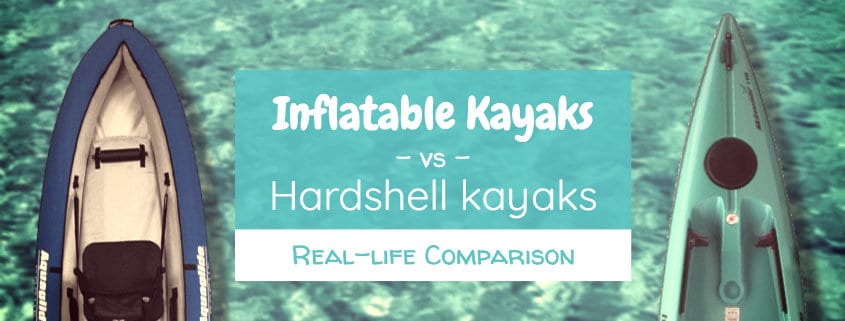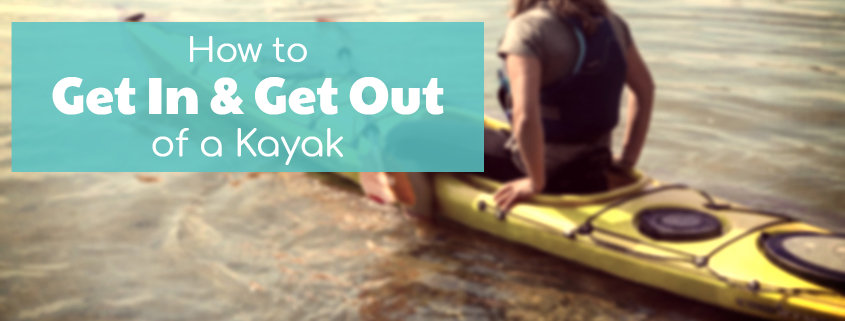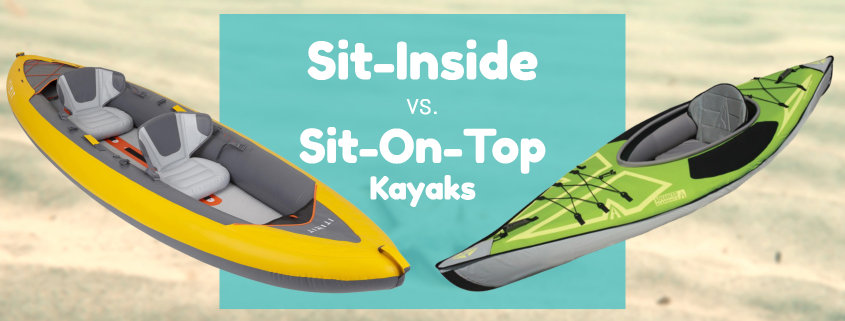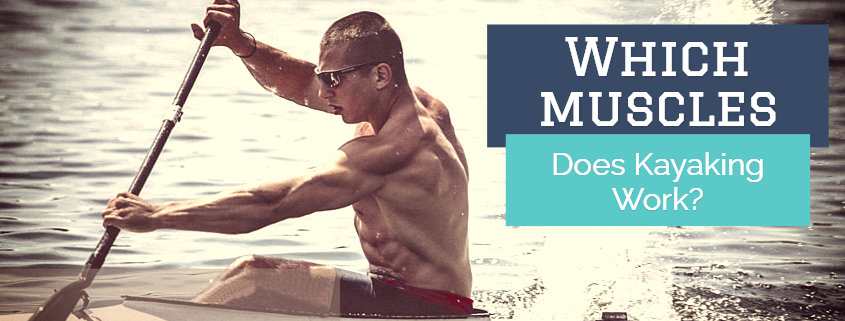Most hard-shell and inflatable kayaks have the option for a skeg or a rudder. But what are they and what do they do?
Contents
What is a Kayak Skeg and How Does It Work?
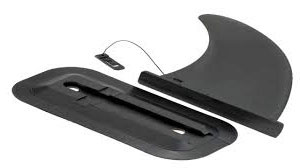
A skeg is a fin (also called a tracking fin) that is either built-into your kayak’s hull or can be attached to it.
It is used to help keep your vessel going straight (tracking) with minimal effort when the wind and waves would affect the boat’s handling. It achieves this by trimming the boat.
Some touring kayaks have adjustable skegs that can be lowered and raised in various increments from the cockpit. Small adjustments in how far it is lowered into the water help trim the boat to handle quartering or crosswinds better.
What is a Kayak Rudder and How Does It Work?

Rudders can be attached to the stern of a kayak or come built-in as through-hull rudders, and are controlled with cables connected to foot pedals. They can be lowered into the water or raised back out as needed.
The main purpose of the rudder is to assist in the tracking (going straight) of your boat, but of course, you can use it to steer as well.
In fact, beginner paddlers think that the rudder is there to help steer. While this is an advantage rudders have, their main function is to keep the kayak going straight. Just like a skeg.
Once lowered into the water, the rudder is controlled with foot pedals. Pushing on the right pedal turns the boat right, the left one turns the boat left.
Kayak Skeg vs Rudder – What is the Difference?
The overall purpose of both the skeg and rudder is to keep the kayak going straight in sub-optimal weather conditions.
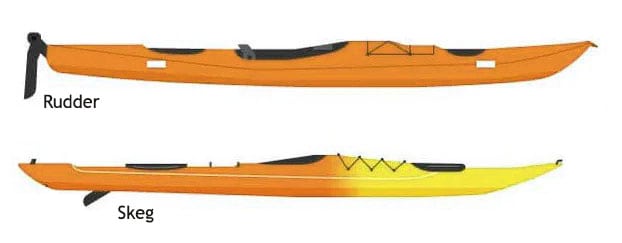
There are some obvious and not so obvious differences between them though:
- The rudder blade can be used to steer a boat, while the skeg is fixed in direction.
- The rudder is mounted to the stern, while the skeg protrudes from the bottom hull.
- On some kayaks, the skeg can be partially deployed. The rudder is either fully up or down.
- The solid foot braces in kayaks with a skeg stay in place and support your feet and legs.
- However, the foot pedal with rudder-equipped kayaks moves, so foot support is not so strong. This is the biggest compromise of rudders for me.
- The more complicated cable mechanism of rudder steering systems will lead to faults sooner or later.
I personally prefer a skeg over a rudder.
Do Kayaks Need a Skeg or Rudder? No!
You might be surprised to read that you don’t necessarily need to use a skeg on a kayak.
Yes, you read that correctly.
In fact, when you take kayaking lessons, instructors will want you to paddle without the skeg until you learn corrective strokes properly. As your paddling skills improve and you learn how to control your yak with just your paddle, you can opt for the luxury of a skeg.
But with that said, you will definitely want to have a tracking fin of some kind on longer trips. Read on to find out why.
Do inflatable kayaks need a skeg though?
The bottom hull of most inflatable kayaks is flat, which makes proper tracking very difficult. Having a skeg definitely helps in keeping inflatables on a straight path.
Some even have 3 skegs!
If your’s doesn’t have a single one, you can retrofit it.
However, the hull of some inflatable kayaks resembles that of their hard-shell counterparts (for example, the Advanced Elements Expedition or the Sea Eagle Razorlite). These have good tracking on their own as well.
When Should You Use a Kayak Skeg/Rudder?
You will want to use a skeg or rudder when paddling in open water (lakes, ocean) for longer periods, as it helps achieve good tracking despite the possibly windy, wavy conditions.
It also useful if your vessel is loaded unevenly.
Let me explain why.
How Weather Conditions Affect Kayak Tracking
Due to their body shape, kayaks will naturally want to turn into the wind. This is called weathercocking. Believe me, paddling with a crosswind for miles on is a pain without something to help tracking…
Here is a brief explanation:
Depending on the shape of their hull, different kayak models will be affected differently by the waves and wind. Some handle sub-optimal weather conditions well, but others need a skeg/rudder to keep them going straight without you having to overly exert yourself with corrective strokes.
You can read about how weathercocking affects tracking in detail here.
How Weight Distribution Affects Tracking
The way your kayak is loaded, so how weight is distributed, will also affect its tracking:
- If the front (bow) is heavier than the rear (stern), then the front will have more sideways resistance to the wind than the rear. This results in extra weathercocking, where your boat points into the wind.
- If the stern is heavier than the front, then the opposite is true. The stern has more sideways resistance to the wind than the bow, and your vessel will point with the wind.
The ideal way to spread the load in your kayak is to achieve neutral trim by having even weight distribution. If the wind picks up, you’ll want less weight in the front and more weight from the center going back. In fact, just shifting your body position by leaning back can already make a difference.
Your skeg also adds sideways resistance to the stern.
When You Should NOT Use a Skeg/Rudder for Kayaking
As you already know, it is better to learn how to paddle without a tracking fin, as it will make you more proficient in the sport.
But there are instances when you should NOT have a skeg or a rudder sticking out from the bottom of your boat:
- If you set out on whitewater kayaking. Whitewater paddling is all about control and maneuvering using proper strokes, not about tracking straight.
- If you paddle in water that has downed trees or rocks near the surface.
- If you paddle in extremely shallow water.
If the skeg can come into contact with anything under the water, it acts as an obstruction and will probably throw you off course, break, or damage your boat.
Which Kayaks Have Skegs?
Not all kayaks have built-in tracking fins.
Touring kayaks intended for long-distance or ocean use will have a skeg or rudder for the extra assistance you need in wind and waves.
Also, the longer the kayak is, the more likely it is to have one.
Most inflatable kayaks have one or more tracking fins though, as their flatter hull design requires it. They might have small, permanently attached skegs, or large removable ones.
Whitewater kayaks do not have them at all, or have removable ones. Also, short recreational kayaks might not have them either.
Proper Use and Care of a Skeg
Before you set out onto the water, you need to understand how to properly attach and use them. Make sure that:
- Removable skegs are locked into the fittings properly, otherwise, they will come loose and you might lose them.
- The kayak’s floor is inflated to the recommended PSI, or the tracking fins will wobble.
Be mindful of the back-end of your yak to protect your skeg (or rudder blade). They are not hard to break or bend.
Be careful when paddling in water that is shallow or has obstructions. Getting out of the boat before hitting the beach and bringing the boat onto shore will prevent any damage to the skeg.
Conclusion
After reading the above, you should know how a skeg works, and when it is needed. Whether you need one is up to you.
Know that even if you buy a kayak that does not have a tracking fin or rudder installed, you can add one later if you need it.


